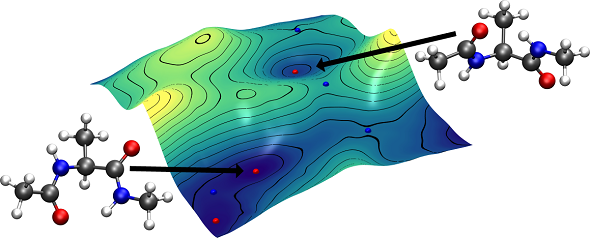Description
|
The minimum-free energy path (MFEP) is the path with the highest statistical weight in a chemical reaction. It provides the information which atoms are in what order involved in the process. The change in the free energy, as well as the free-energy barrier can be obtained from the MFEP. The former is for example the free energy of binding of a ligand to its receptor. The latter can be used to calculate the rate of a reaction employing transition state theory. This allows the investigation of processes slower by many orders of magnitude than those directly accessible my molecular dynamics.
Here, we develop a method to find the MFEP using umbrella sampling. The first two derivatives of the free energy with respect to certain atom coordinates are calculated using umbrella integration [1]. These derivatives at a number of points along the path allow to converge a test path to the MFEP. Traditionally, only the first derivative was accessible, which limits geometry optimization techniques to linear optimizers. Umbrella integration allows to calculate the second derivative from MD simulation data. This will improve the convergence of path optimizations.
The method is intrinsically parallel: MD simulations have to be performed at all points along the path (about 20–100) independently of each other. These MD simulations can also be parallelized. This allows the use of modern compute clusters with thousands of processors.
[1] J. Kästner, W. Thiel, J. Chem. Phys. 123, 144104 (2005)


